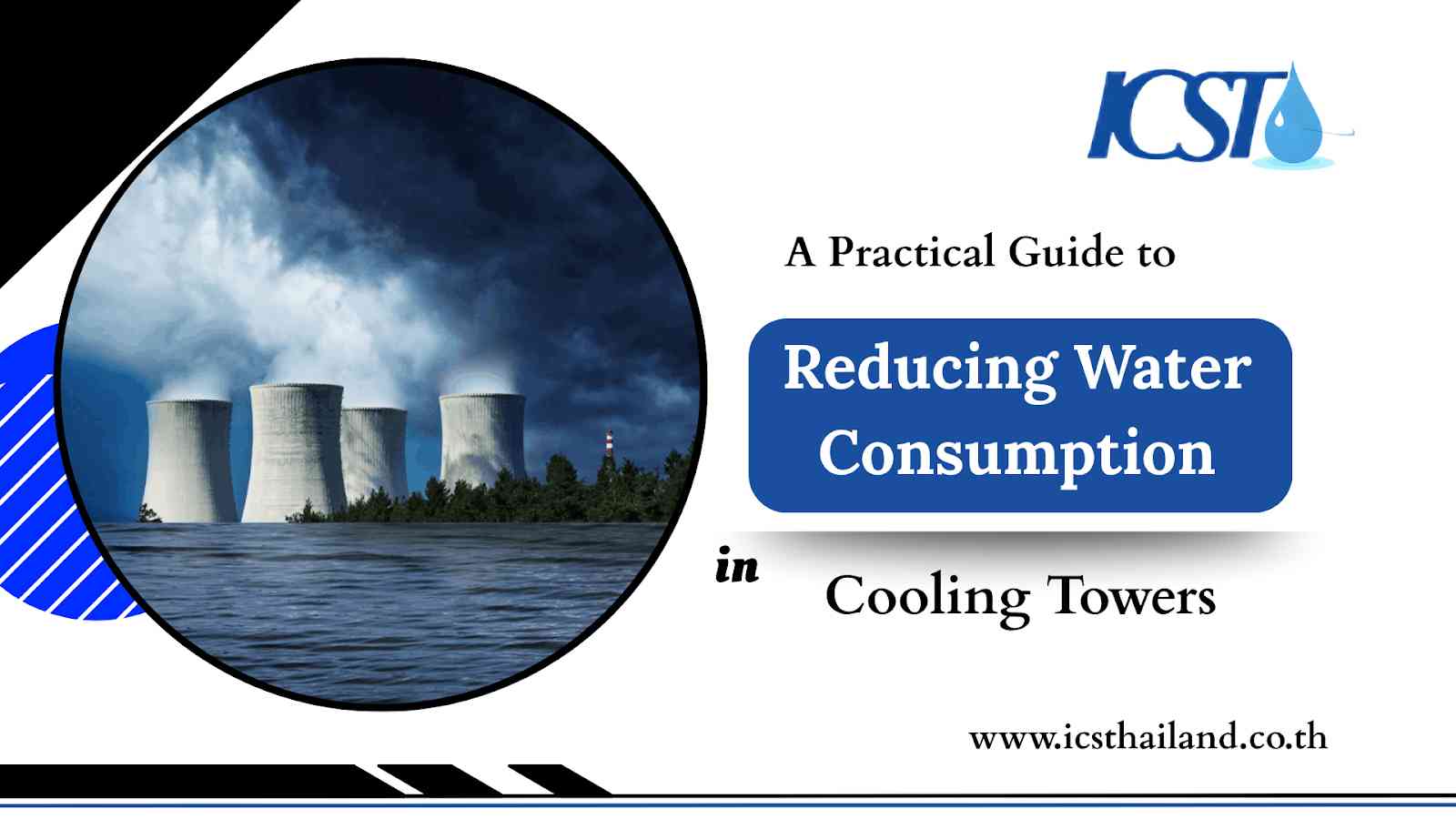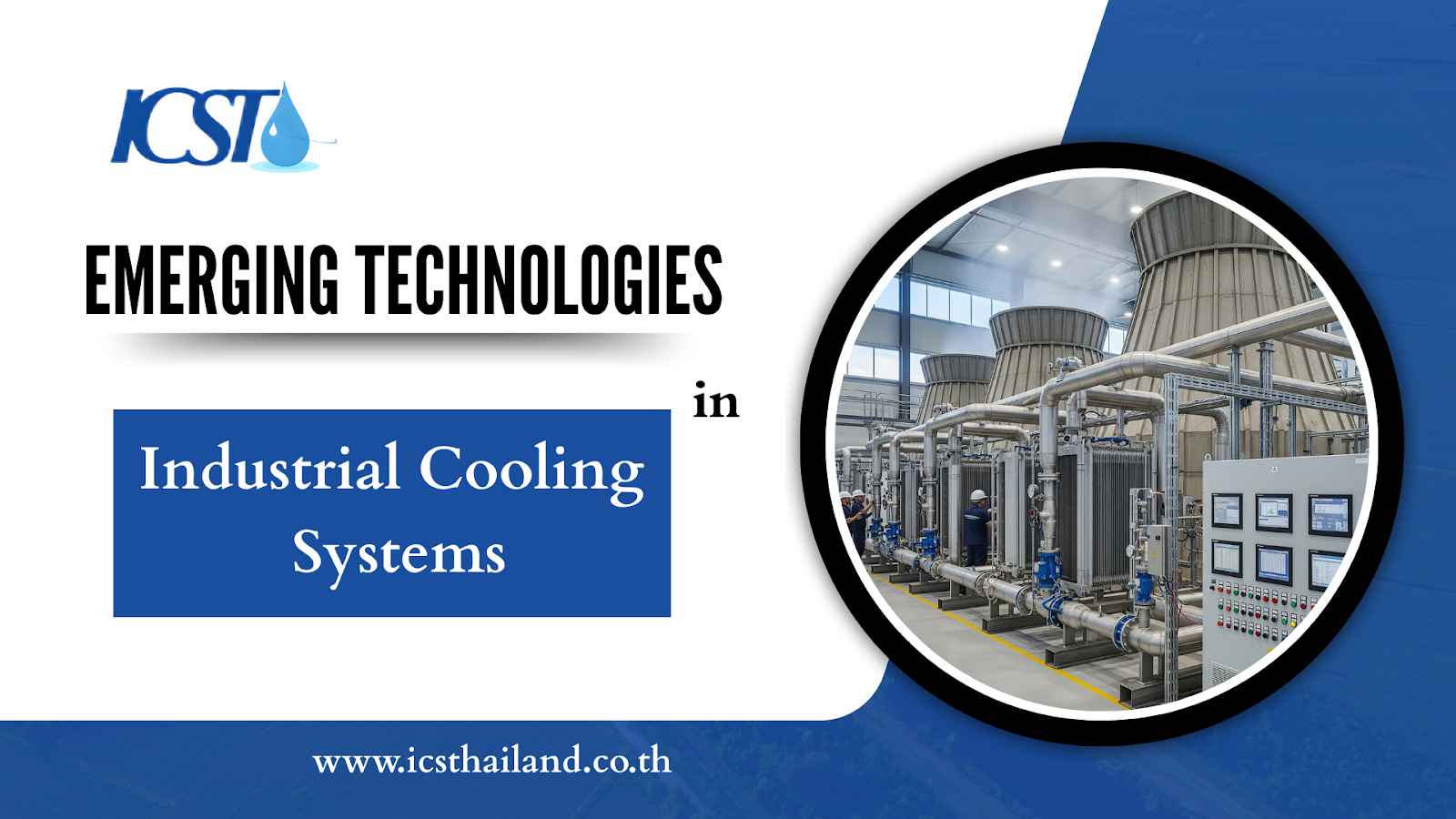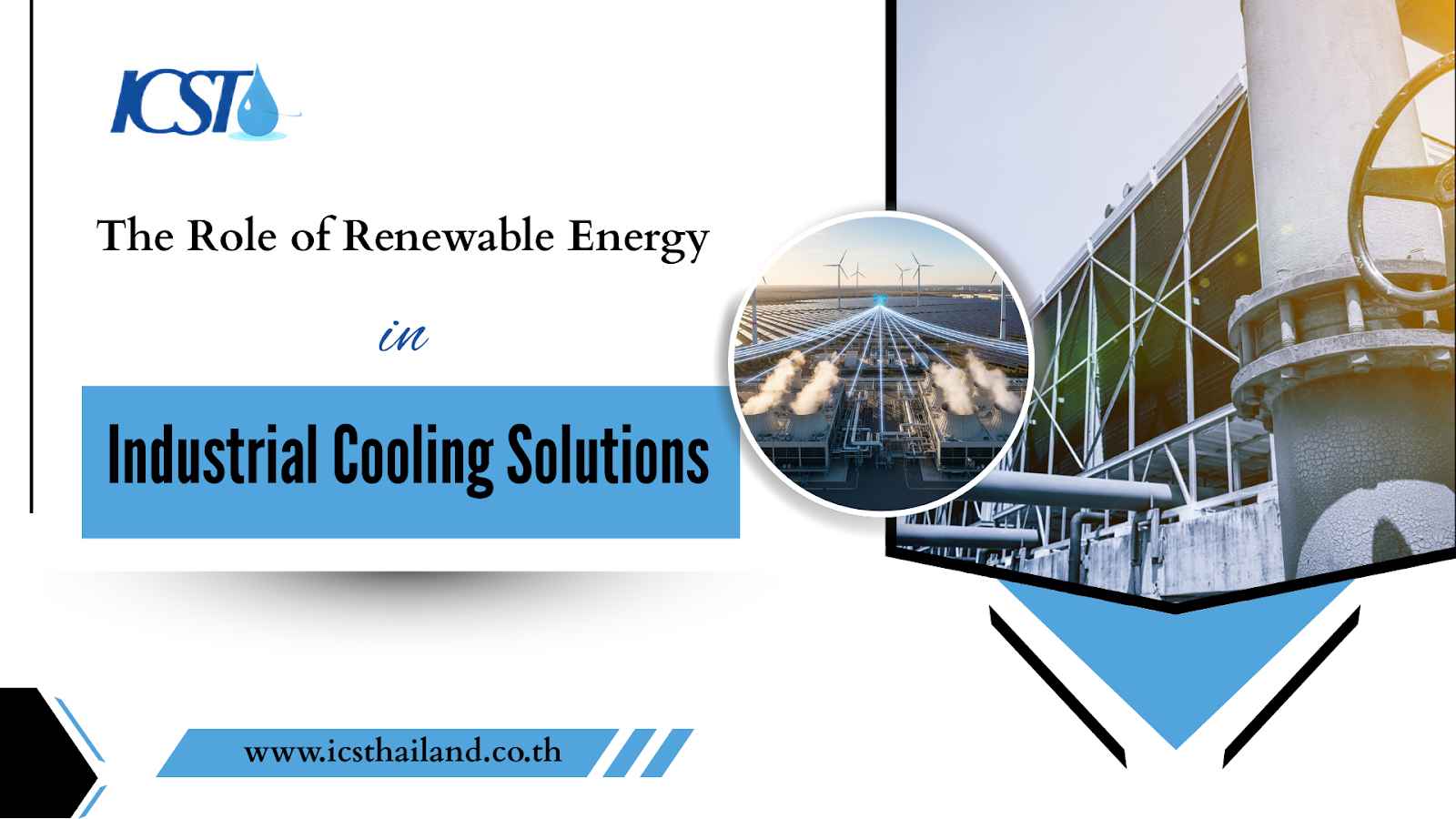Water costs are rising across Thailand’s industrial sector, putting unprecedented pressure on facility managers to find sustainable solutions. Environmental regulations are tightening, and corporate sustainability goals demand immediate action. Yet many facilities overlook their biggest opportunity for water conservation.
Cooling towers typically account for 80-90% of a facility’s total water consumption. A single industrial cooling tower can consume thousands of liters per day, making it both the largest consumer and the greatest conservation opportunity. The challenge isn’t just about reducing costs.
This guide outlines practical strategies for reducing water consumption in cooling towers, helping industrial facilities across Thailand cut usage by 30-60%. These proven solutions deliver real, measurable results within just a few months of implementation.
Table of Contents
ToggleUnderstanding the Three Types of Water Loss
Every drop of water lost from your cooling tower falls into one of three categories, each requiring a different conservation approach.
- Evaporation represents the intentional water loss that creates the cooling effect your system requires. This process cannot be eliminated without compromising performance. However, the other two types of water loss offer significant conservation opportunities.
- Drift occurs when tiny water droplets get carried away by exhaust air instead of falling back into the system. Modern facilities lose 0.02-0.05% of their circulating water to drift, but older systems can lose ten times more.
- Blowdown is the process of intentionally removing concentrated water from a system to minimize mineral deposits and corrosion. In most cooling towers, this is the primary source of preventable water loss. Poor blowdown management can lead to facilities using 20-40% more water than needed.
Strategy 1: Optimizing Operations for Maximum Efficiency
Cycles of Concentration
Cycles of Concentration measure how many times the dissolved minerals in your cooling water have been concentrated compared to fresh makeup water. This single metric determines your system’s water efficiency more than any other factor.
The majority of facilities typically run at 3-4 cycles of concentration; however, with proper management, systems can achieve 6-8 cycles safely.
Higher COC means your system extracts maximum cooling from every liter of water before discharge becomes necessary. This isn’t just conservation, it’s optimization.
Automating Blowdown Control
Manual blowdown systems waste significant amounts of water, as they don’t adapt to real-time system conditions. Even timer-based systems fall short, discharging water unnecessarily during low-load periods.
Automated blowdown systems, however, offer a smarter, more efficient solution by using conductivity sensors to monitor and control water chemistry in real-time, reducing water waste and improving system performance. Here’s why upgrading to an automated blowdown system adds value:
- Water savings: Reduces blowdown water waste by 40-60% compared to manual processes.
- Real-time monitoring: Conductivity sensors track dissolved solid levels to maintain optimal water chemistry.
- Increased efficiency: Automatically adjusts to system demands, maximizing cycles of concentration (COC).
- Cost reduction: Saves on water, energy, and chemical expenses, leading to significant operational savings.
Strategy 2: Advanced Water Treatment and Filtration
The Role of Filtration
Frequent blowdowns are often necessary to control fouling and biological growth caused by suspended particles and organic matter, which build up faster than dissolved minerals. These contaminants limit your system’s cycles of concentration (COC) potential, resulting in water and energy inefficiencies.
Here’s an overview of two effective filtration approaches:
- Side-Stream Filtration: Removes 10-20% of the water in circulation, filters out solid particles, and recirculates clean water back into the system. This continuous cleaning allows higher COC operation, reduces fouling, and extends the time between major cleanings. It is energy-efficient and suitable for systems with moderate contamination levels.
- Full-Flow Filtration: Processes 100% of circulating water, providing comprehensive contaminant removal. However, it requires larger equipment and consumes more energy, making it ideal for systems with high contamination or more stringent water quality requirements.
Both methods can deliver significant water savings and operational benefits within six months, depending on your specific water quality and conservation goals.
Non-Chemical and Side-Stream Treatment
Traditional chemical water treatments can limit system efficiency by increasing dissolved solids, which makes blowdown necessary at lower cycles of concentration (COC).
Here’s a breakdown of the most effective non-chemical treatment options:
- UV Disinfection Systems: Eliminate biological growth without adding any chemicals, ensuring cleaner water and reducing the need for maintenance.
- Ozone Treatment: Breaks down organic contaminants while also controlling microbes, offering a dual benefit for water quality improvement.
- Electronic Water Treatment: Uses electromagnetic fields to modify mineral crystal formation, reducing scale buildup and allowing safer operation at higher COC levels.
Strategy 3: Technology and Equipment Upgrades
High-Efficiency Drift Eliminators
Advanced drift eliminators prevent 99.95% of water droplets from escaping with exhaust air. Older systems may capture only 90-95%, resulting in significant water waste over time.
High-efficiency eliminators use advanced blade designs and longer path lengths to trap more droplets without increasing fan power requirements. The initial investment typically pays for itself within 12-18 months through reduced makeup water costs.
These upgrades are particularly cost-effective for facilities with visible water plumes or nearby equipment showing signs of water exposure from drift.
Upgrading to Efficient Components
Variable Frequency Drives (VFDs), high-efficiency motors, and premium fill media are key upgrades that can significantly enhance cooling tower efficiency, saving water, energy, and operational costs.
When paired with effective water treatment, these solutions deliver long-term benefits by reducing waste and preventing system inefficiencies.
Key benefits include:
- VFDs on fan motors: Maintain consistent airflow across varying load conditions, preventing water chemistry fluctuations and excessive blowdown. This allows for higher cycles of concentration (COC) and reduces water waste during load changes.
- High-efficiency motors: Decrease energy consumption while supporting optimal heat transfer. Improved heat transfer not only saves energy but also minimizes the water evaporation required for cooling.
- Premium fill media: Increases the heat transfer surface area, enabling more efficient cooling with less water evaporation. When combined with advanced water treatment, it prevents fouling and ensures long-term system performance.
Exploring Hybrid Cooling (Advanced)
Hybrid cooling towers use a combination of wet evaporative cooling and dry heat rejection to significantly lower water usage when weather conditions are favorable. These systems can cut water usage by 20-50% depending on local climate conditions.
During cool or low-humidity periods, the dry section handles most heat rejection while the wet section provides supplemental cooling only when needed. This dynamic operation matches water usage to actual cooling demands rather than peak design conditions.
The technology requires a higher initial investment but delivers substantial long-term water savings for facilities with year-round cooling loads and variable ambient conditions.
Quantifying the Cost of Water Loss: A Look at Blowdown
Every liter discharged carries expensive treatment chemicals, while incoming makeup water requires fresh chemical treatment and conditioning.
Consider the financial impact of optimizing COC on a typical 1,000-ton cooling tower system:
| Metric | Before Optimization (3 COC) | After Optimization (5 COC) |
| Annual Makeup Water | 450,000 liters | 270,000 liters (-40%) |
| Annual Blowdown Water | 150,000 liters | 60,000 liters (-60%) |
| Annual Chemical Costs | ฿180,000 | ฿108,000 |
| Annual Water & Disposal Savings | ฿156,000 |
These savings compound annually while reducing environmental impact and regulatory compliance costs. By addressing water consumption in cooling towers, businesses can achieve significant resource optimization. This typically requires minimal capital investment but delivers immediate operational benefits.
Your 5-Step Water Conservation Checklist
Ready to implement these water-saving strategies? Here’s your action plan:
Step 1: Conduct an internal water audit.
- Begin by recording your existing water usage, COC levels, and the frequency of blowdowns
- Include data on water chemistry, such as pH, conductivity, and hardness, to gain a comprehensive understanding of system performance.
- This baseline not only helps track progress but also identifies inefficiencies and potential areas for improvement.
Step 2: Optimize your system’s Cycles of Concentration.
- Increasing your system’s COC is one of the most effective ways to save water.
- Begin with automated blowdown control to ensure precision and avoid human error, then incrementally raise the COC while consistently monitoring water chemistry for scaling and corrosion risks.
- Studies have shown that most systems can safely achieve 5-6 cycles, but some high-quality water sources allow for even greater efficiency when paired with robust management practices.
Step 3: Evaluate and upgrade to high-efficiency components.
- Upgrading your system’s components can significantly reduce water losses and improve overall efficiency.
- Begin by installing efficient drift eliminators to reduce water loss through vapor.
- Next, consider replacing outdated fill media to improve heat transfer efficiency.
- Additionally, upgrading to variable frequency drives (VFDs) for motors can optimize energy and water use by adjusting speed to match demand.
Step 4: Investigate advanced water treatment technologies.
- Explore cutting-edge options such as non-chemical treatment systems, like electrolysis or UV-based solutions, to reduce reliance on traditional chemicals.
- Enhanced filtration systems, such as ultrafiltration or reverse osmosis, can improve water quality and allow for higher COC levels.
- Evaluate these technologies based on factors like your water source, waste disposal regulations, and long-term cost-effectiveness.
Step 5: Consult with an expert to develop a tailored strategy.
- Hire a water management expert to perform a thorough evaluation of the system.
- They can help you design a conservation plan that addresses your specific operational needs, aligns with local regulations, and maximizes resource efficiency.
- A customized approach ensures you implement best practices while avoiding unintended consequences, such as scaling, corrosion, or regulatory non-compliance.
The Financial and Environmental Benefits
Water conservation in cooling towers is not just an environmental responsibility; it’s a smart business strategy that delivers tangible benefits across cost, compliance, and operations. Let’s explore how water conservation creates value for your business:
- Significant Cost Savings: Lower water purchases, reduced chemical usage, and minimized wastewater disposal fees can generate rapid ROI, with many facilities recovering optimization investments in just 12-24 months.
- Simplified Regulatory Compliance: Proactive water conservation demonstrates a commitment to meeting environmental regulations, reducing the risk of fines and penalties. Facilities with measurable reduction targets are increasingly favored under Thai environmental policies.
- Strengthened Corporate Sustainability: Water conservation supports environmental stewardship, boosting your company’s sustainability profile. Many global customers now demand that suppliers show evidence of conservation efforts to align with their green initiatives.
- Improved Operational Efficiency: Optimized water chemistry reduces scale, corrosion, and fouling in cooling systems, leading to longer equipment lifespans, fewer unplanned repairs, and more predictable maintenance schedules.
Conclusion
Cooling tower water conservation requires a systematic approach combining operational optimization, advanced treatment, and strategic equipment upgrades. The most successful facilities implement these strategies progressively, starting with high-impact, low-cost improvements before advancing to more sophisticated technologies.
These conservation measures deliver both immediate operational benefits and long-term competitive advantages. Facilities that act now position themselves ahead of inevitable water cost increases and regulatory changes while demonstrating environmental leadership.
Start your water conservation journey today by conducting a comprehensive cooling tower assessment. A professional evaluation identifies your highest-impact opportunities to reduce water consumption in cooling towers and develops a customized implementation plan. Visit the ICST website now to learn more and get started!
Frequently Asked Questions
How do cooling towers lose water?
Cooling towers primarily lose water through evaporation (for cooling), drift (water droplets carried away by air), and blowdown (controlled removal of concentrated water). Evaporation is necessary, while drift and blowdown can be minimized.
What are Cycles of Concentration (COC)?
Cycles of Concentration measure how many times minerals in cooling water have been concentrated compared to fresh makeup water. Increasing COC reduces the amount of fresh water needed, significantly improving water efficiency.
How does automated blowdown save water?
Automated blowdown systems use sensors to monitor water chemistry in real-time, discharging only when necessary. This prevents excessive water waste common with manual or timer-based systems, maximizing Cycles of Concentration.
Can filtration reduce water consumption in cooling towers?
Yes, filtration removes suspended solids and contaminants that cause fouling, allowing for higher Cycles of Concentration.
Do non-chemical water treatments save water?
Yes, non-chemical treatments reduce the need for traditional chemicals that can limit Cycles of Concentration by adding dissolved solids. This allows the system to operate at higher COCs, leading to less blowdown and more water savings.







